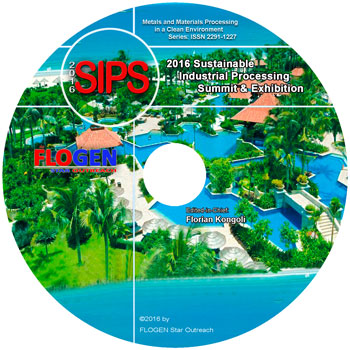2016-Sustainable Industrial Processing Summit
SIPS 2016 Volume 6: Yagi Intl. Symp. / Metals & Alloys Processing
| Editors: | Kongoli F, Akiyama T, Nogami H, Saito K, Fujibayashi A |
| Publisher: | Flogen Star OUTREACH |
| Publication date: | 21 December 2016 |
| Pages: | 480 pages |
| ISBN: | 978-1-987820-46-1 |
| ISSN: | 2291-1227 (Metals and Materials Processing in a Clean Environment Series) |

CD shopping page
Industrial Solids Processing Applications: Particle Reaction Models and Bed Combustion Models
Sangmin Choi1;1KOREA INSTITUTE OF SCIENCE AND TECHNOLOGY,DEPARTMENT OF MECHANICAL ENGINEERING, Daejeon, Korea (Republic of [South] Korea);
Type of Paper: Keynote
Id Paper: 298
Topic: 3
Abstract:
Industrial applications for solids processing are commonly associated with the gas-solid particle reactions. Since the overall performance and productivity of the process depend on the treatment of gas-solid reactions, the proper reaction modeling is crucial in constructing an effective bed reactor model. The current study discusses the mathematical modeling procedure of bed type reactors that simplifies the bed structure and encompasses the particle reaction models referring to some industrial cases of solids processing.
Regarding the complex nature of the gas-solid particle reaction, various modeling studies have been conducted from the perspective of the single particle. The approaches hitherto proposed can be distinguished by the manner of the reaction progression, as well as whether it gives analytic or numerical solution. Among the models, the shrinking core model and the grain model are the two widely applied concepts.
The use of the reaction model in the bed process modeling should be based on the particle structure, reaction kinetics, and simultaneous heat and mass transfer effects. For instance, a discussion can be made about the frequent use of the shrinking core model for coke combustion in the pellet indurator modeling. Since the shrinking core model assumes a nonporous single particle, it may have limitations in representing the reaction progression in a pellet mostly attributed to pellet porosity and the sizes of a pellet and the coke lump. For this case, the grain model would become more advantageous.
Based on the discussion about single particle reaction models, the bed process modeling cases are presented. The typical simplifying approach using the porous media approximation and one or two dimensional numerical solution procedure could cover various applications, such as iron ore sintering, iron ore pellet indurator, mass-burn waste incinerator, and blast furnace.